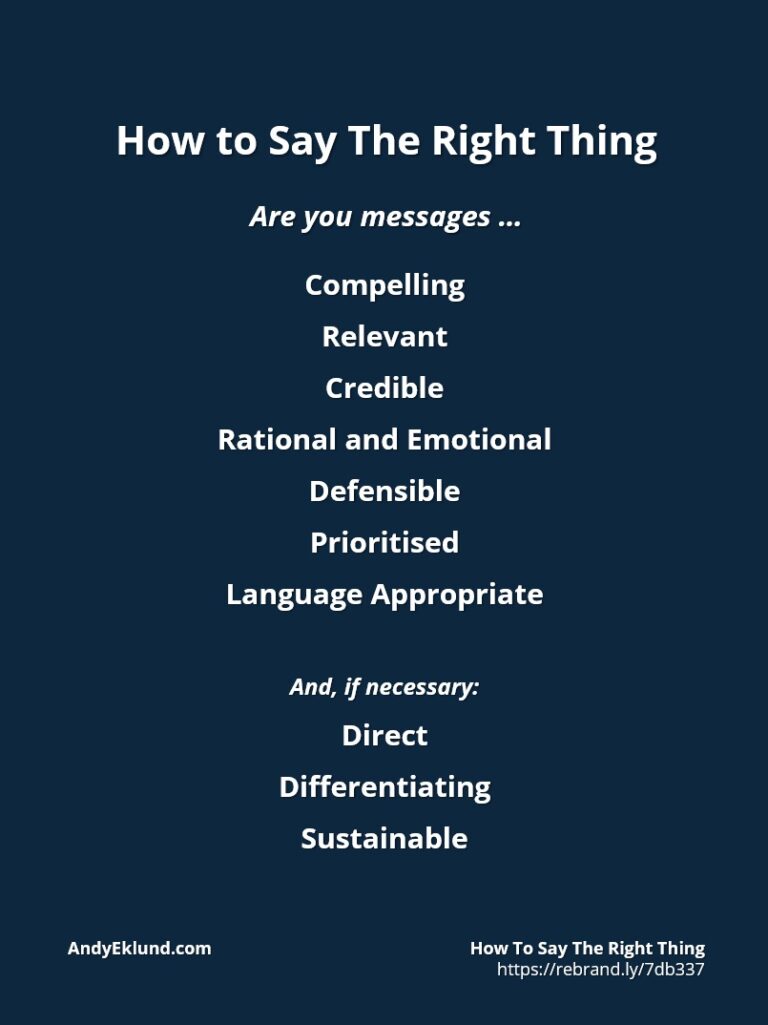Communications has been my entire career. Most of that time was me doing the communicating, but likely as much time was spent writing messages for someone else to say. Did I ever know if I was saying the right thing?
To be honest, I never knew precisely if I was giving myself, my executives or my clients the best messages to say. Most of it was instinctive, to be honest. However, it’s impossible to force your gut reaction or intuition to work on command.
It’s easy (tempting? natural?) to just open your mouth and say the first thing that comes out. Unfortunately, once you say something (right or wrong), you can’t take it back.
I took an initial list given to me many years ago, adapting it as I went along. Here are seven critiera I frequently use to decide if I’m saying the right message, with an optional three more to consider depending upon the context and situation.
Make your messages:
- Compelling
- Relevant
- Credible
- Rational and emotional
- Defensible
- Prioritised
- Language appropriate
And, if necessary:
- Direct
- Differentiating
- Sustainable
How To Say the Right Thing, in Detail
Before you read the detailed list below, remember that – like all business knowledge – messages without context are useless.
If you want to say the right thing, ask if your messages are …
Compelling?
You should tell the audience what you want them …
- To do (or how to behave)
- To think (what you’re saying is not optional)
- To consider (what you’re saying may be optional)
Relevant?
You should speak to the audience’s point-of-view, not yours. More so, do not speak as the organisation which is passive and (oftentimes) insulting. Speak as a real, authentic person who is representing the organisation.
Credible?
Your messages are believable, honest, genuine, and supportive of the organisation’s vision and mission.
Rational and Emotional?
You are balancing facts with feelings. As Aristotle taught us, all coherent arguments are both.
Defensible?
The messages, evidence and ideas will stand up in a court of law.
Prioritised?
Put the most important information first.
Harold Burson once told me that when you’re talking to someone, it’s like being in an elevator or lift with your audience. Yes, it’s the proverbial elevator pitch, but he added one key aspect most forget or don’t know. The elevator pitch suggests you’re going from the bottom to top floor, but what happens if the other party gets out on an earlier floor? Did you have your messages in priority order?
In other words, do not put your main message at the end!
Language Appropriate?
You have used words and phrases which are appropriate to the audience.
Also, avoid speaking in metaphors, especially if your language isn’t the first language of your audience. If the audience doesn’t know English for example, “I’m going to take you on a journey” could confuse them.
The previous seven are strongly suggested.
The three below are optional, depending upon the audience, situation and culture.
Direct?
It’s always good to be clear and direct, but at the same time, be careful of being direct in cultures or situations where being direct is not appropriate. Passive voice may be more suitable.
Differentiating?
You want your messages to be attached to you, the department, the organisation. If there’s any competition – external or internal – make your messages specific.
A simple tip: If you replaced your organisation’s name (or similar) with your competition, will your messages still work?
Sustainable?
This criterion is only necessary if your messages last forever. If your messages are only good for the quarter, or until another round of (different/nuanced) messages are needed, don’t worry so much if your messages last. At the same time, if your messages will change, best to let your audience know that so you don’t look like you’re unable to make a decision and stick to it.
Any other criteria you’ve used to make sure your saying the right thing? Please add your comments and thoughts below.



No comment yet, add your voice below!